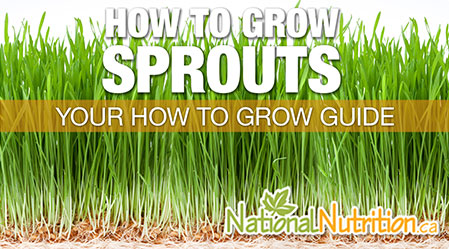
How to Grow Sprouts
Updated Dec. 06th, 2022
Growing sprouts are easy once you know how and get the hang of it.
Sprouts are mostly grown from grains, seeds and legumes.
Not all grains, seeds and legumes can be sprouted however.
This is a guide for your reference on how to grow your own sprouts.
Growing sprouts is an easy way to include your family in a fun healthy practice of growing food right at home.
What Are Sprouts?
Sprouts are the colourful plant-like growth which forms when certain foods are soaked in a small amount of water. Soaking begins a natural process called germination. Nature uses seeds, grain, nuts, and legumes to grow new plants, and it all begins with a germination process.
When these foods become wet it catalyses growth enzymes to begin a chemical process for the growth of a new plant. This is called a sprout and sprouts are highly dense with enzymes, vitamins, minerals and phytochemicals.
In addition to being a living, enzyme–rich food, sprouts have many vitamins and minerals. By sprouting these foods, the vitamin and mineral content of them increases.
For instance the vitamin A content in sprouts doubles, B vitamins will increase 5 – 10 times, and vitamin C will also increase.
Once sprouted, the protein in grains, seeds, and legumes also become more digestible, and therefore more bio-available. This is especially important for those who are vegetarians.
What Can Be Sprouted?
Beans and Legumes: lentils, peas, chick peas, mung bean, navy, pinto, black, lima, adzuki
Seeds: alfalfa, clover, fenugreek
Cereal grains: oat, corn, rice, barley, wheat
Pseudo cereal grains: quinoa, amaranth, buckwheat
Oil seeds: sesame, sunflower, flax seed
Nuts: almond, hazelnut
Brassica family seeds: broccoli, cabbage, watercress, mustard, radish, daikon, arugula, mizuna, turnip, tatsoi
Certain grains and legumes can be poisonous, harmful or just plain unable to sprout and should be avoided: soy and kidney beans, white rice, oat grouts, tomato, potato, paprika, eggplant, and rhubarb
Most sprouted beans and legumes have hemagglutinins, which inhibit the absorption of fats and proteins. Hemagglutinins however are destroyed by cooking so these sprouts are best cooked in curries, soups, stir fries or made into a dip or pate.
How To Sprout?
First - rinse the seeds, nuts, legumes or grains. This removes any debris or mucilaginous material that may have grown if the food was in contact with any moisture.
Second - to germinate, cover and soak seeds, nuts or grain in water for 20 min to 12 hours depending on the size and density of the food.
Once soaked for a sufficient time they are ready to sprout.
Third – to sprout, rinse the germinated seeds, legumes and grain. Then add enough water that they are wet but not covered. You want some air contact at this point but only enough water to prevent drying out. This combination of water and air will begin the sprouting phase and you will begin to see bits or white and green begin to form. Some seeds can even sprout beautiful colour like pinks and purples. Be sure to continue to rinse the seeds, grain or legumes 2 to 4 times daily until you are happy with the amount of sprouting. Then move them into the fridge to slow the process down.
Soaking increases the water content in the seed, legume or grain bringing them out of their dormant state called quiescence.
It is important to drain, rinse and add fresh water two to four times daily to ensure negative bacterial growth will not grow.
Each seed, grain or legume has its own time it takes to sprout. This is variable depending on conditions such as air temperature, water temperature and size of the seed, grain or legume. Generally, the warmer the air temperature the faster the spouts will germinate and grow. Refrigeration will slow and even halt the sprouting process.
The following is a reference guide for how long to soak legumes, seeds and grains for.
Nutritional Information
| nut and seed sprouting chart |
|||
|---|---|---|---|
| an easy guide to follow for successful seed sprouting |
|||
| type of seed | quantity | soaking time | growing time |
| beans (all) | 1 cup | 10-12 hours | 3-5 days |
| chickpea | 1 cup | 12 hours | 3 days |
| fenugreek | 4 tbs. | 6 hours | 3-5 days |
| lentils (all) | 1 cup | 6-8 hours | 3-4 days |
| mung bean | 1 cup | 8-10 hours | 3-5 days |
| nuts (all) | 1 cup | 24 hours | 1 day |
| rye berries | 1 cup | 8-10 hours | 3-4 days |
| pumpkin seeds | 1 cup | 8 hours | 1-2 days |
| sunflower seeds | 1 cup | 8 hours | 2 days |
| soft wheat berries | 1 cup | 10-12 hours | 2-3 days |
How Do You Use Sprouts?
Sprouts are great on salads, on sandwiches, or blended in health shakes.
There is just no wrong way of eating them.
One exception is they are best eaten raw. Cooking them can neutralize their beneficial enzymes. The exception to this are the beans and legumes listed above. These are best eaten cooked.






















I tried to home grow green sprouts, I consider I had failed because the sprouts are very thin and short, nothing to compare those from the super market.
Is there any nutrition supplements to help producing better sprouts.
Can I grow the green bean in pot soil and how ?
Hello,
Thank you for your question, we're glad to see you're enjoying the articles. We offer Biosnacky seeds and growing containers by A. Vogel. They are linked here:
https://www.nationalnutrition.ca/catalogsearch/result/?q=biosnacky
They are a great way to grow sprouts easily. Have a healthy day!
I have sprouted a couple of kinds of beans: mung and garbanzo (chick peas). I have a pot and drainer that fit together with the drainer on top. The drainer has fairly large holes in it. I rinse and soak according to the instructions in this article, and then sprout them in cheesecloth. The garbanzos are really crunchy. I just eat them raw. I tried sprouting white rice once, but as you say in the article, nothing happened.
Great article. I love sprouting and have tried a few different seeds. Fenugreek is quite nice and has a curry flavor to it. I also really like sprouting french lentils and alfalfa. I knew kidney beans were toxic but I wasn't aware of the other seeds/beans/grains that were toxic as well. Interesting that white rice shouldn't be sprouted but brown rice can be.
Hello Stephanie,
Thank you for sharing your tips and we're glad you were able to learn more about sprouting in our article!
Have a healthy day!